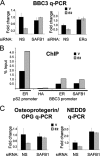SAFB1 mediates repression of immune regulators and apoptotic genes in breast cancer cells
- PMID: 19901029
- PMCID: PMC2823501
- DOI: 10.1074/jbc.M109.066431
SAFB1 mediates repression of immune regulators and apoptotic genes in breast cancer cells
Abstract
The scaffold attachment factors SAFB1 and SAFB2 are paralogs, which are involved in cell cycle regulation, apoptosis, differentiation, and stress response. They have been shown to function as estrogen receptor corepressors, and there is evidence for a role in breast tumorigenesis. To identify their endogenous target genes in MCF-7 breast cancer cells, we utilized a combined approach of chromatin immunoprecipitation (ChIP)-on-chip and gene expression array studies. By performing ChIP-on-chip on microarrays containing 24,000 promoters, we identified 541 SAFB1/SAFB2-binding sites in promoters of known genes, with significant enrichment on chromosomes 1 and 6. Gene expression analysis revealed that the majority of target genes were induced in the absence of SAFB1 or SAFB2 and less were repressed. Interestingly, there was no significant overlap between the genes identified by ChIP-on-chip and gene expression array analysis, suggesting regulation through regions outside the proximal promoters. In contrast to SAFB2, which shared most of its target genes with SAFB1, SAFB1 had many unique target genes, most of them involved in the regulation of the immune system. A subsequent analysis of the estrogen treatment group revealed that 12% of estrogen-regulated genes were dependent on SAFB1, with the majority being estrogen-repressed genes. These were primarily genes involved in apoptosis, such as BBC3, NEDD9, and OPG. Thus, this study confirms the primary role of SAFB1/SAFB2 as corepressors and also uncovers a previously unknown role for SAFB1 in the regulation of immune genes and in estrogen-mediated repression of genes.
Figures





References
-
- O'Malley B. W. (2007) Mol. Endocrinol. 21, 1009–1013 - PubMed
-
- Acevedo M. L., Lee K. C., Stender J. D., Katzenellenbogen B. S., Kraus W. L. (2004) Mol. Cell 13, 725–738 - PubMed
-
- Dobrzycka K. M., Townson S. M., Jiang S., Oesterreich S. (2003) Endocr. Relat. Cancer 10, 517–536 - PubMed
-
- Oesterreich S., Zhang Q., Hopp T., Fuqua S. A., Michaelis M., Zhao H. H., Davie J. R., Osborne C. K., Lee A. V. (2000) Mol. Endocrinol. 14, 369–381 - PubMed
Publication types
MeSH terms
Substances
Associated data
- Actions
Grants and funding
LinkOut - more resources
Full Text Sources
Molecular Biology Databases

